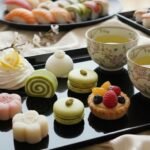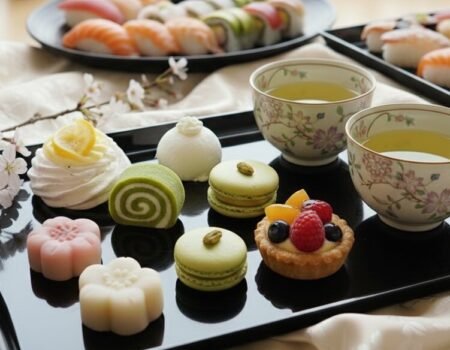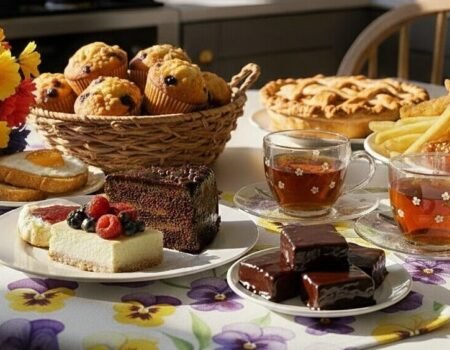
Seasonal Tea Pairing: Best Tea and Food Combinations by Season
Index
Seasonal tea pairing is the simple idea of matching fresh, local ingredients with teas that naturally complement them. Think crisp green tea with spring asparagus, or warming chai with winter baking. Each season brings its own flavors, and the right tea can make them even better.
This guide will walk you through how to match tea with food throughout the year. You’ll probably be surprised at how these simple pairings can transform your everyday meals.
Key Takeaways
- Seasonal tea pairing enhances taste by matching teas like green, black, oolong, and chai to local produce and traditional dishes for each season.
- Spring favors first flush Darjeeling or white teas with fresh vegetables, while summer highlights iced herbal blends paired with grilled foods.
- Fall features bold oolongs and black teas alongside root vegetables or spiced desserts; winter pairs strong blacks and pu-erh with hearty stews and baked goods.
- Cultural traditions such as Japanese matcha in cherry blossom season or Chinese Longjing during Qingming Festival highlight seasonal harmony in tea selection.
- Adjusting tea type and serving temperature, hot in cold months, iced during summer, maximizes flavor balance between food pairings all year round.
How Does Season Affect Tea and Food Pairing?
Season shapes tea and food pairing through natural changes that influence how we taste and what we crave.
When you sip tea with seasonal ingredients, you tap into nature’s rhythm. Your palate responds differently to flavors in March than it does in August.
Seasonal Ingredients and Flavors
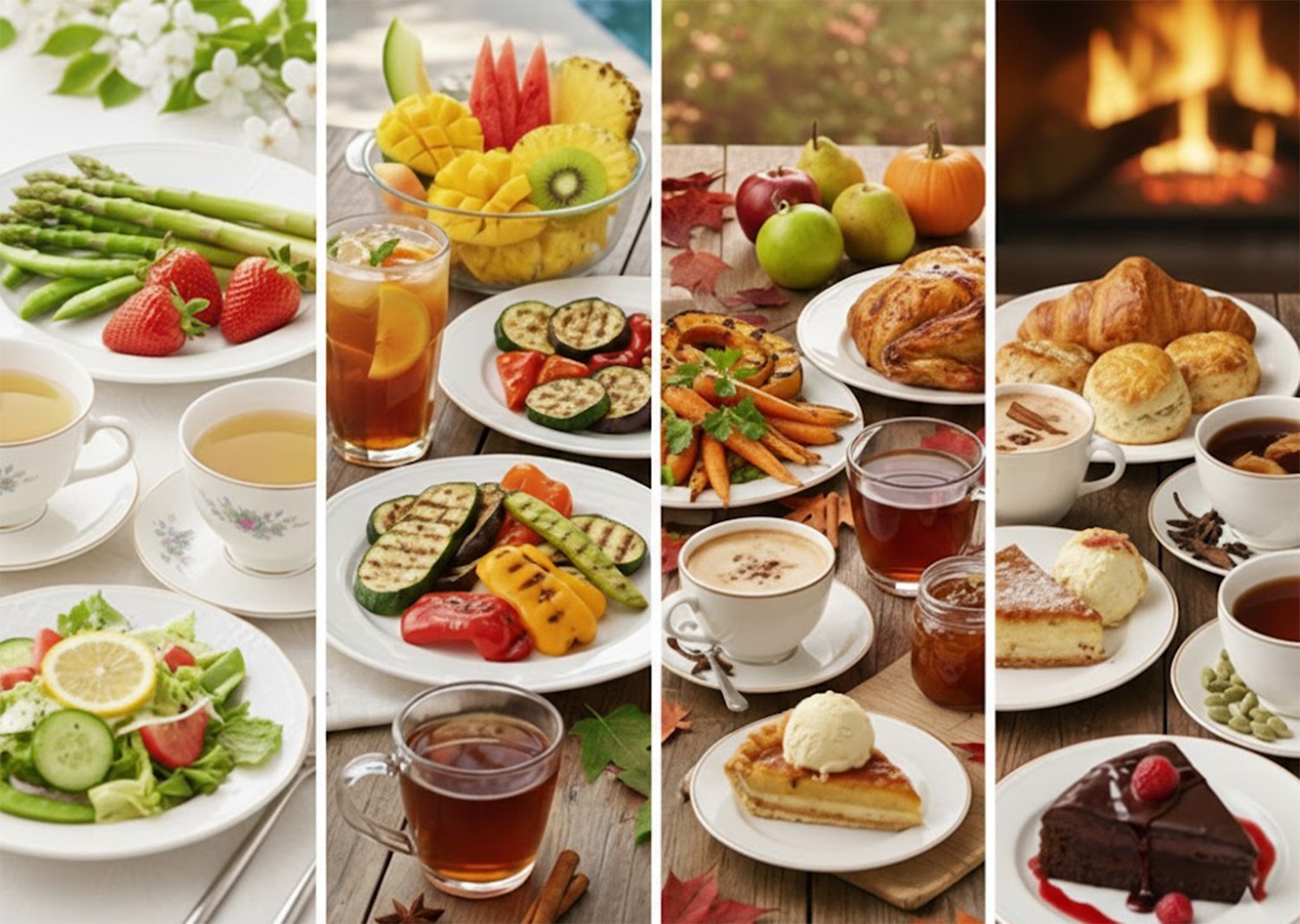
Local farmers’ markets drive the best tea pairings. Fresh produce at peak ripeness brings out flavors that packaged foods simply can’t match.
In spring, you’ll find tender asparagus, snap peas, and bright strawberries that pair beautifully with first flush Darjeeling. White tea complements light spring salads dressed with lemon juice or topped with melon slices. The delicate nature of these early-season teas enhances the sweet, grassy notes of young vegetables without overwhelming them.
Summer delivers vibrant tropical fruits. Mango, pineapple, watermelon, kiwifruit, and peach create natural matches for iced tea with citrus slices. These combinations balance sweet fruit plates and complement grilled vegetables from your barbecue. Herbal blends such as rooibos offer naturally caffeine-free options packed with fresh apricot or berry notes that cool your palate on hot days.
Fall brings hearty root vegetables. Carrots, squash, apples, pears, and pumpkin gain depth when paired with black teas like Assam or spiced chai infused with cinnamon and clove. Roasted meats pair naturally with full-bodied oolongs whose caramel aroma lingers between each bite of roast chicken. Spiced apple desserts taste even better when you sip vanilla-scented Earl Grey alongside warm apple preserves.
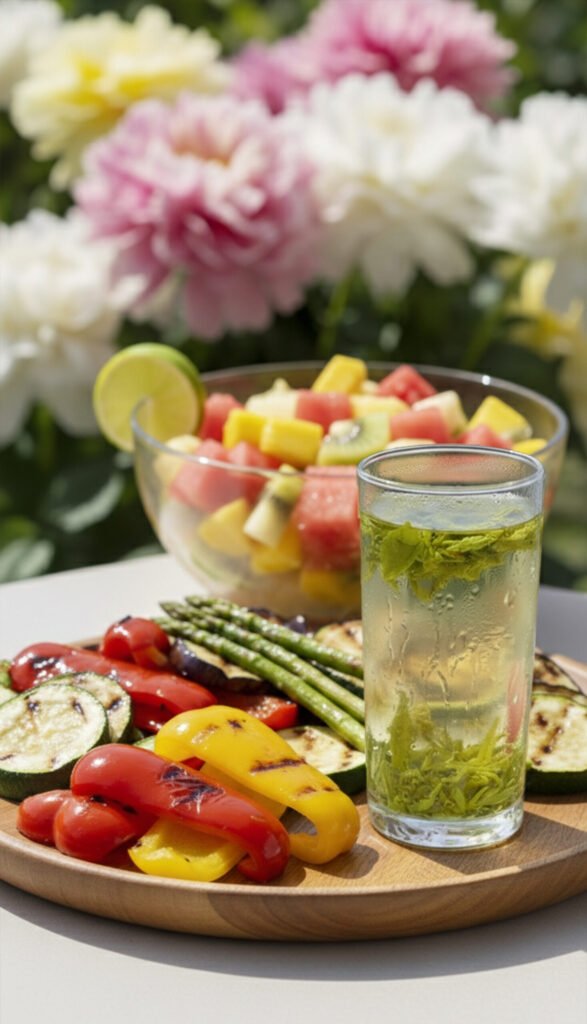
Winter demands rich, warming ingredients. Buttery baked goods pair perfectly with strong breakfast blends or malty black teas from late-season harvests. Chai brings comfort through cardamom and ginger blended into thick winter baking. Pu-erh teams up beautifully with dark chocolate cake, its earthy taste profile reminiscent of forest floor after rain.
Temperature Considerations
Hot tea amplifies the warmth of hearty dishes during colder months.
Steaming brews like black tea, pu-erh, and chai enhance the comforting effect of stews and baked goods. In Japanese rituals, matcha served warm creates a cozy experience, especially alongside winter baking or citrus desserts.
Cold brew tea and iced blends transform summer meals. Chilled sencha refreshes your palate when paired with grilled vegetables or tropical fruit salads. Tea lovers often choose peppermint or herbal infusions over ice at picnics because these flavors stay light and crisp on hot days.
Adjusting serving temperature allows each kind of tea to reach its best potential. Warm Darjeeling tea matches spring’s mild mornings but feels too intense under summer sun. Cold lapsang soothes after smoky barbecues yet seems out of place beside autumn apple desserts unless you serve it gently warmed instead of piping hot.
Cultural Seasonal Traditions
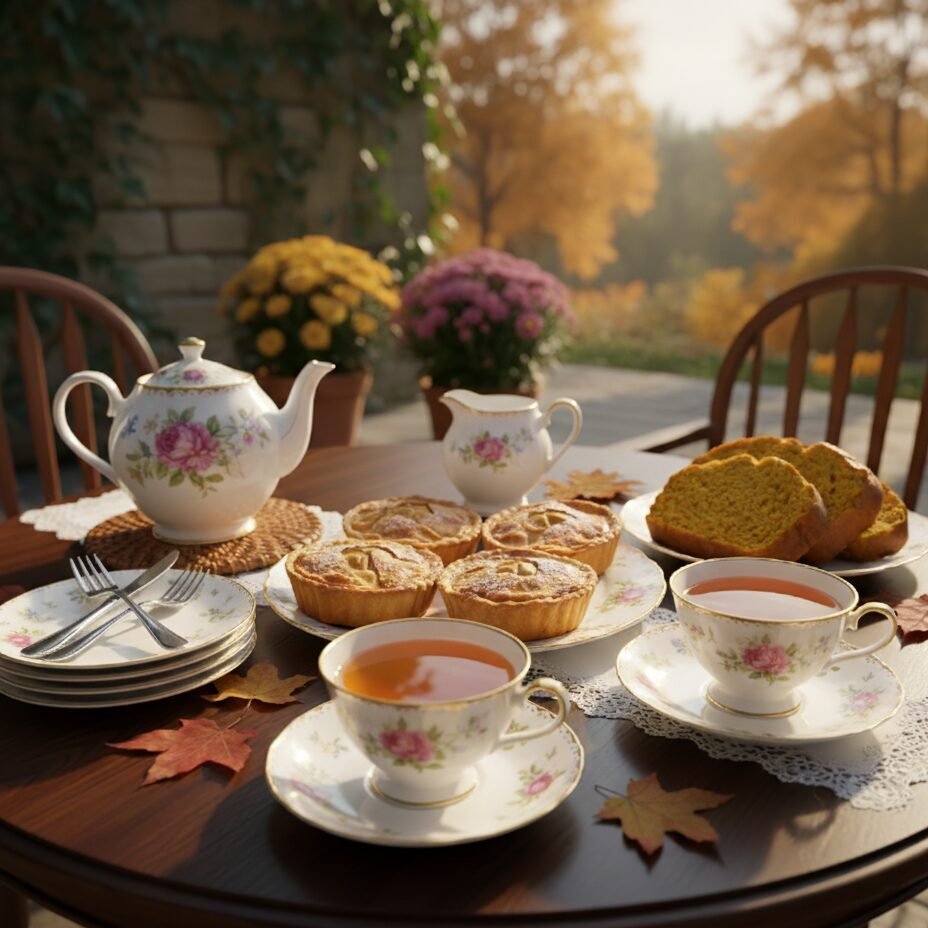
In Japan, tea ceremonies follow the rhythm of cherry blossoms and changing leaves. The practice of pairing matcha tea with wagashi sweets during spring cherry blossom season reflects a deep respect for nature’s cycles. Each season brings specific tea utensils, flower arrangements, and sweets designed to honor that particular time of year.
Chinese seasonal tea practices date back to the Tang dynasty. Tea farmers select specific harvest times based on agricultural signals, such as the Qingming Festival in early April that marks the first plucking of prized green teas like Longjing. As each season changes, Chinese households adjust brewing styles, steeping time, and water temperature, to pair with both food flavors and weather conditions.
British afternoon tea adapts its offerings with each season. Spring brings light Darjeeling alongside cucumber sandwiches or lemon cakes during midday gatherings. Summer features iced black tea with fresh berries or scones filled with clotted cream. Autumn tables showcase robust Assam or spiced chai paired with apple tarts and pumpkin bread. Winter afternoons include rich English Breakfast blends served hot, accompanied by mince pies and buttery shortbread for warmth.
Seasonal change brings new flavors; let your teacup follow the rhythm.
What Are the Best Spring Tea and Food Pairings?
Spring teases your senses with light and fresh teas that highlight seasonal ingredients like strawberry, pea shoots, and tender greens.
You’ll discover naturally sweet flavors and bright, astringent notes that make each tea experience vibrant.
Spring Tea Characteristics
Delicate, light, and fresh qualities define spring teas. Tea plants awaken after winter dormancy and unfurl their first flush of tender leaves between late February and April.

The 2025 first flush Darjeeling harvest began on March 20, according to The Republic of Tea. These young buds come from estates in China’s famous tea gardens and the Himalayan slopes of West Bengal. Spring green teas like Longjing display a bright green color, grassy aroma, and crisp body with an astringent taste. White teas such as Bai Mudan capture subtle floral notes alongside a naturally sweet finish.
These early shoots have lower caffeine than summer harvests because the camellia sinensis plant stores fewer compounds over cold months. The teas often carry hints of pea shoots, snap beans, or newly-mown grass. Their scent can remind you of rose petals or magnolia blossoms carried by cool winds.
Many people describe spring tea as lively on the palate yet smooth enough to pair well with tangy fruits like strawberry or mild nuts like peanut.
First Flush Teas with Spring Vegetables
First flush teas like Darjeeling arrive at the start of spring with light, floral notes that match fresh spring vegetables.
I’ve found these teas work beautifully with asparagus, peas, and young carrots. The crispness in first flush Darjeeling brings out the sweet and grassy flavors from seasonal greens.

Chefs often pair first flush Darjeeling or green tea with lightly steamed asparagus or sautéed snap peas. The mild bitterness in early-picked greens balances smoothly against the gentle sweet finish of these teas. Many tea enthusiasts also serve white steamed bok choy alongside a black and green tea blend during spring meals. This pairing complements both texture and taste without overpowering delicate vegetable flavors.
Green Tea with Asparagus and Peas
Following the vibrant notes of first flush teas, green tea shines when paired with fresh asparagus and sweet peas.
The grassy flavor in green tea matches perfectly with these spring vegetables. It enhances the sweetness in peas and emphasizes the tender earthiness of asparagus. Steamed asparagus brings out subtle nutty undertones in many Chinese or Japanese green teas like sencha or Dragonwell.
You might notice how a cup of sencha cuts through natural bitterness, leaving your palate refreshed. This pairing offers a lighter experience than black tea pairing with heartier foods. It showcases how seasonal produce can elevate even simple cups.
White Tea with Spring Salads
White tea offers a subtle floral aroma and delicate sweetness that highlights fresh greens and mild vegetables in spring salads.

Baby spinach, butter lettuce, or young arugula pair especially well with white tea due to their gentle flavors. Chopped nuts like almonds or walnuts add welcome texture while echoing the light earthiness found in premium Bai Mudan.
Tossed tomato slices complement the faint fruit notes of white tea and keep the salad bright. A simple vinaigrette made from orange juice brings acidity that balances both the soft leaves and mellow brews. Smoked cheese shavings can add complexity if you want a savory twist to contrast the clean finish of high-quality white teas.
Spring Tea with Strawberries and Rhubarb
Strawberries and rhubarb reach their peak in spring, and their sweet-tart profile offers an exciting contrast to subtle teas.
First flush Darjeeling or delicate green teas provide floral notes that meld beautifully with juicy berries and tangy rhubarb desserts.
You can serve a light tea-infused shortcake topped with macerated strawberries and cooked rhubarb for an elevated treat. Use a splash of bergamot orange essence or classic Earl Grey tea syrup to bring out citrus highlights and complement the fruit’s natural acidity. For those preferring caffeine-free options, rooibos tea goes well with strawberry-rhubarb compote thanks to its gentle sweetness and earthy undertones.
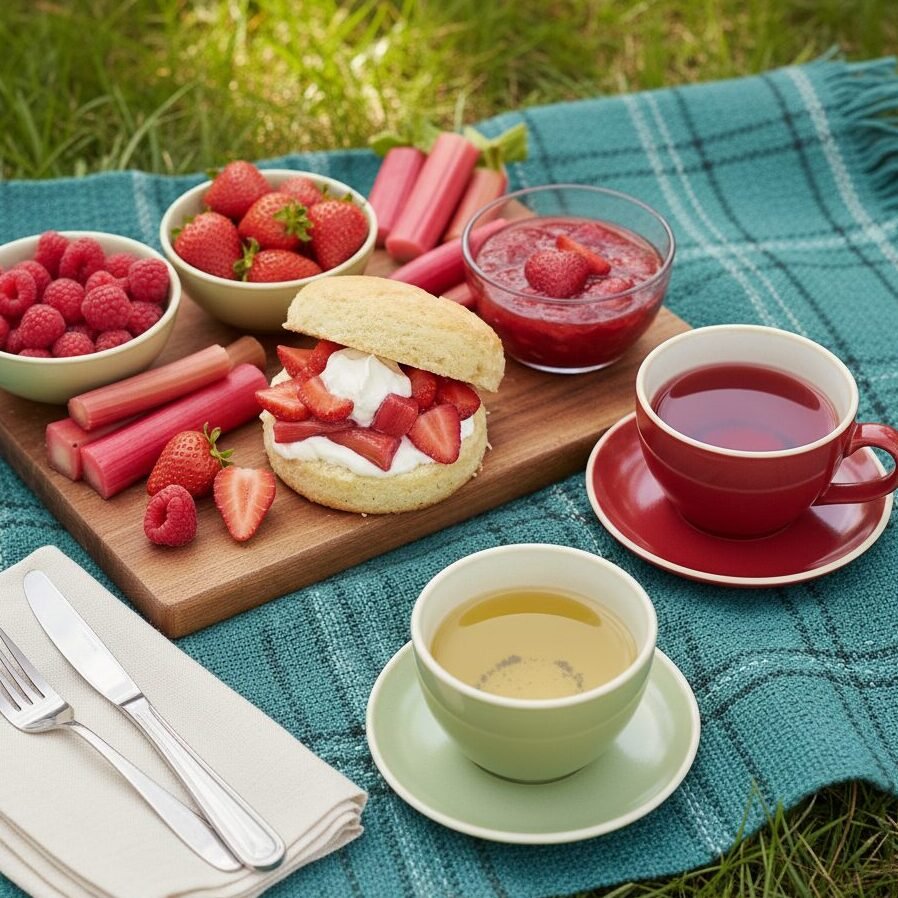
Try serving slices alongside a charcuterie board at your next spring brunch. This approach balances savory bites while letting seasonal fruits shine.
What Tea Pairs with Summer Foods?
Summer calls for teas that refresh and balance vibrant meals or smoky foods from grilling.
You’ll discover how to match the right tea with every spicy flavor and seasonal spread that makes warm-weather dining memorable.
Summer Tea Characteristics
Hot days often call for lighter teas with crisp, refreshing flavors. Green tea, white tea, and many herbal blends shine during summer because they offer a cooling sensation.
Iced teas stand out as the perfect choice to balance spicy flavor in barbecue dishes or tropical salsas.
Teas like verbena bring citrus aroma that complements seafood or roasted vegetables finished on a grill. Oolong gains popularity for its floral notes and smooth finish. It enhances smoked fish or cold salads made with peanut butter dressings. Smoky teas such as hojicha also work well when served chilled next to foods cooked by roasting or smoking.
Iced Tea and Summer Meals

Iced tea brings crisp refreshment to summer meals.
Tall glasses of cold black tea or green tea cut through the richness of barbecue, fried chicken, and creamy salads. Lemon wedges, mint sprigs, and a few berries boost flavor without heavy sweetness. Many people prefer unsweetened iced teas with grilled meats because subtle tannins enhance smoky flavors similar to wine and food pairing techniques.
Cooks often serve iced oolong or floral herbal teas at cookouts to balance spicy marinades or bring out fresh notes in tomatoes and cucumbers. Iced jasmine green tea pairs well with light smoked fish dishes since its aroma lifts delicate flavors without overpowering them. Green tea’s gentle bitterness also works well alongside simple grilled vegetables.
Green Tea with Grilled Vegetables

Green tea’s gentle flavors help cool the palate after smoky, high-heat cooking.
Freshly brewed Sencha or Dragon Well amplifies the sweetness of charred bell peppers and zucchini while taming bitterness in eggplant or asparagus. Grilling vegetables brings out caramelized notes that blend well with the grassy qualities of steamed Japanese green teas.
The light body and faint astringency scrub away oil from smoked foods, creating balance in each bite. Using smoking techniques for your carrots or mushrooms adds depth to their taste, making them an even better match for vegetal teas like Mao Feng or Huangshan Maofeng.
Serve your green tea slightly warm to contrast chilled summer sides. Try it cold if you prefer delicate refreshment alongside salty grilled corn.
Oolong with Summer Seafood

Oolong tea highlights the sweet brininess of summer seafood. Its floral aroma and light toasted notes match beautifully with grilled shrimp, steamed clams, or fresh crab salads.
The tea’s mild astringency cuts through oilier dishes like smoked salmon or pan-seared scallops, keeping your palate refreshed after each bite. Cold-brewed oolong works especially well during hot days because it provides cooling relief without overpowering delicate fish flavors.
Look for lightly oxidized oolongs such as Tie Guan Yin or Baozhong to let seafood shine while still adding depth from the tea’s subtle earthiness. Smoking methods create bolder tastes in dishes like smoked mackerel. Here, roasted oolongs add a nutty counterpoint that softens strong smoky edges.
Herbal Tea with Tropical Fruits
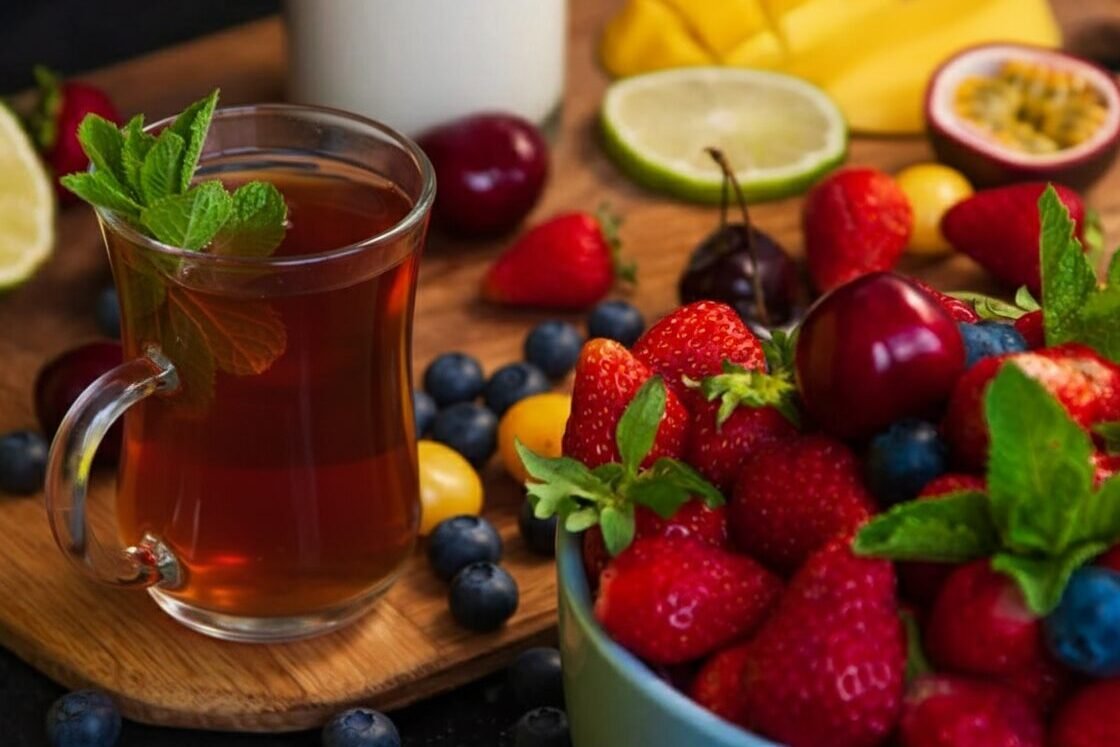
Hibiscus tea pairs beautifully with mango, pineapple, and passion fruit. The tart notes in the herbal tea balance the natural sweetness of ripe tropical fruits.
You can brew a strong pot of hibiscus or lemongrass tea, then chill it over ice for a refreshing drink that highlights summer flavors. Top each glass with fresh fruit slices to boost aroma and add texture. Fruit forward teas like these work perfectly at poolside gatherings or outdoor brunches.
Their caffeine-free nature suits all ages and preferences on hot days.
Cold Brew Tea with BBQ
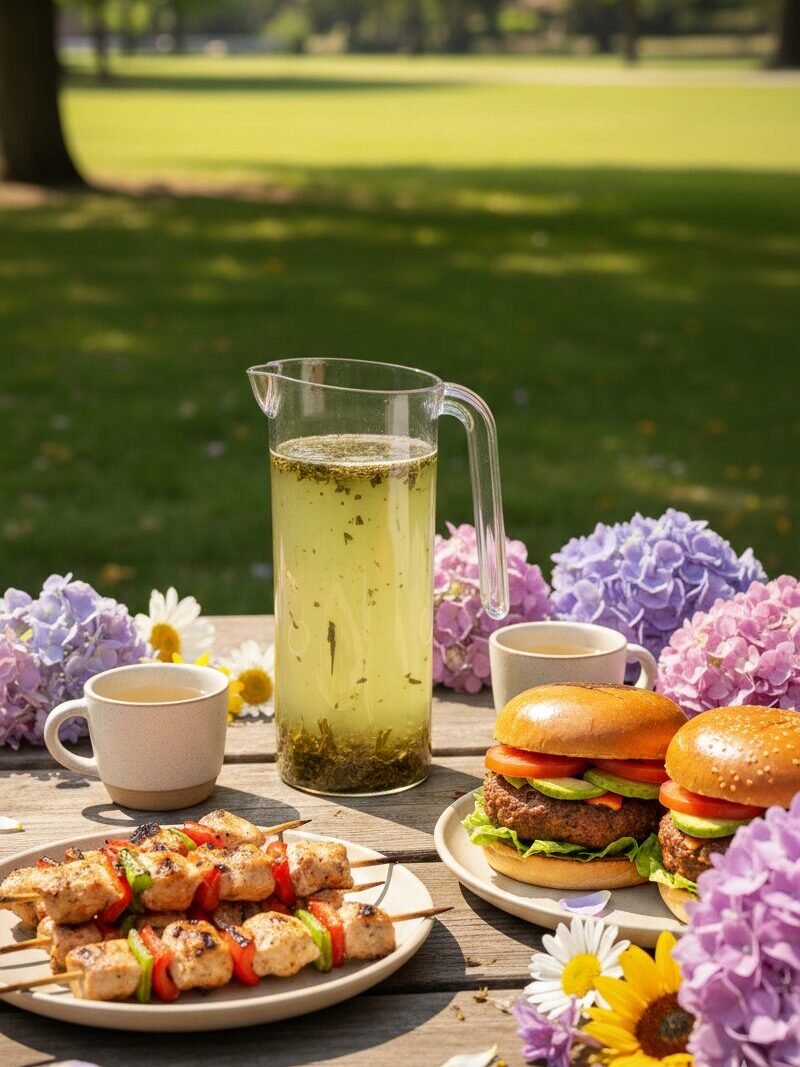
Cold brew tea stands out next to smoky barbecue flavors. Cold brew green tea offers a cool, grassy taste that calms the heat of grilled meats.
Black teas, steeped slowly in cold water, give a malty and slightly sweet backbone that matches barbecue sauce’s bold spices. Peach oolong or iced jasmine tea refresh the palate between bites of spicy ribs or charred corn on the cob.
Guests often prefer unsweetened cold brews for lighter meals like chicken skewers or veggie burgers. For richer options such as brisket or pulled pork, serve chilled lapsang souchong. Its natural smokiness lines up perfectly with wood-fired dishes. Citrus slices or fresh mint make easy garnishes for these teas at outdoor gatherings.
How to Pair Tea with Fall Foods
Fall brings earthy flavors and cozy meals, making it the ideal time to explore new tea and food pairings.
You can highlight autumn ingredients with teas that match their rich, warming character.
Autumn Tea Characteristics
Hearty flavors make autumn teas stand out. Oolong and black teas bring deeper, toasted notes that match the season’s cooler air.
Leaves pick up extra warmth during their late harvest, resulting in coppery hues and gentle sweetness. Many oolongs release scents of roasted nuts or baked fruit, while black teas grown for autumn deliver smooth tannins with hints of honey or malt.
Steamed cups reveal thicker textures than most spring or summer brews. These teas balance briskness and richness, creating a bold profile without harsh edges. Soft smokiness sometimes appears in pu-erh and darker oolongs harvested in this period.
Oolong with Roasted Root Vegetables
Oolong tea matches beautifully with roasted root vegetables like carrots, parsnips, and sweet potatoes.
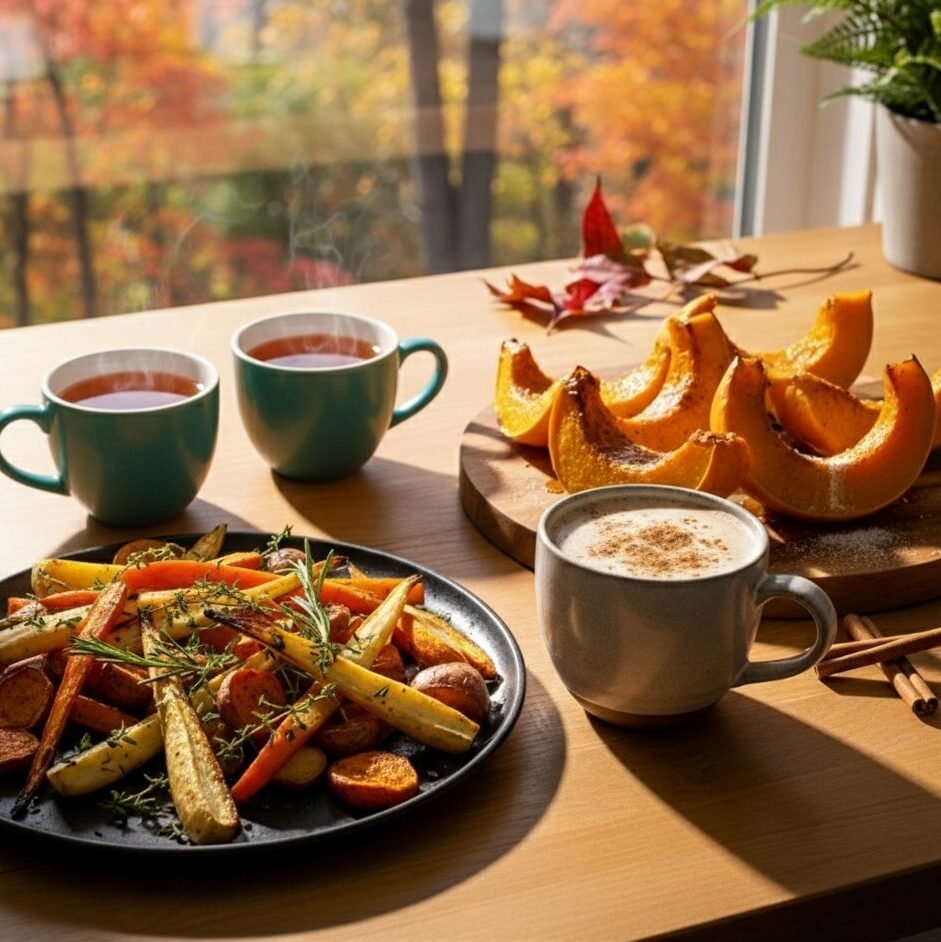
The tea’s floral notes bring out the earthy flavors in the vegetables while its slight astringency cuts through natural sweetness and caramelized edges. You can serve a warm cup of medium-roast oolong next to oven-roasted beets or potatoes to balance their hearty texture and depth.
Choose an oolong that carries nutty or honeyed undertones for extra harmony with browned vegetables. Steep your leaves at 190°F (90°C) for about three minutes. This gentle brew draws out aroma without overpowering delicate vegetable flavors. Oolong’s complexity stands up to savory glazes like miso or soy sauce, making every bite more interesting as you sip between forkfuls.
Black Tea with Pumpkin and Squash
Black tea stands up well to the buttery flavors of pumpkin and squash. Its bold taste balances the sweetness and creamy texture of these fall vegetables.
You might select a brisk Assam or a malty Yunnan black tea for extra depth. Steep your tea hot to highlight its warm notes, then serve it with roasted acorn squash drizzled in olive oil or spiced pumpkin soup. The earthy undertones of black tea bring out subtle hints of caramel in both dishes.
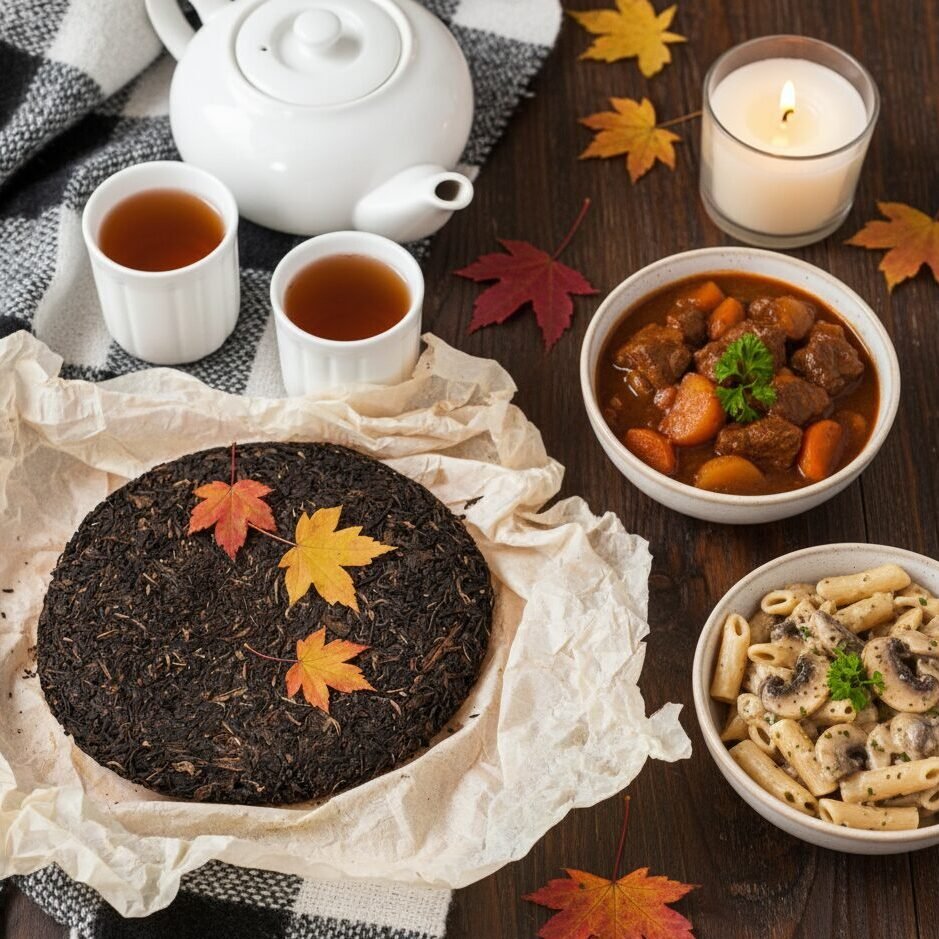
Try pairing spiced black teas like chai with baked pumpkin slices dusted in cinnamon or nutmeg. The spices echo each other and create an inviting autumn scent at the table.
Pu-erh with Hearty Stews
Pu-erh tea matches beautifully with hearty stews during the fall. Its earthy and deep flavor can stand up to rich, slow-cooked dishes like beef stew, mushroom ragout, or bean chili.
The aged character of pu-erh cuts through fatty meats and thick broths while highlighting savory notes in root vegetables. Sipping pu-erh between spoonfuls helps reset your taste buds so each bite feels fresh. Many cooks appreciate the way pu-erh’s gentle astringency reduces heaviness after a meal packed with potatoes, carrots, or braised lamb.
Serve this tea hot to warm up cool evenings and bring out more sweetness from both the tea leaves and the stew’s ingredients.
Spiced Tea with Apple Desserts
Spiced tea pairs perfectly with apple desserts during autumn. Cinnamon, cloves, and cardamom in chai or other spiced blends bring out the warmth of baked apples.
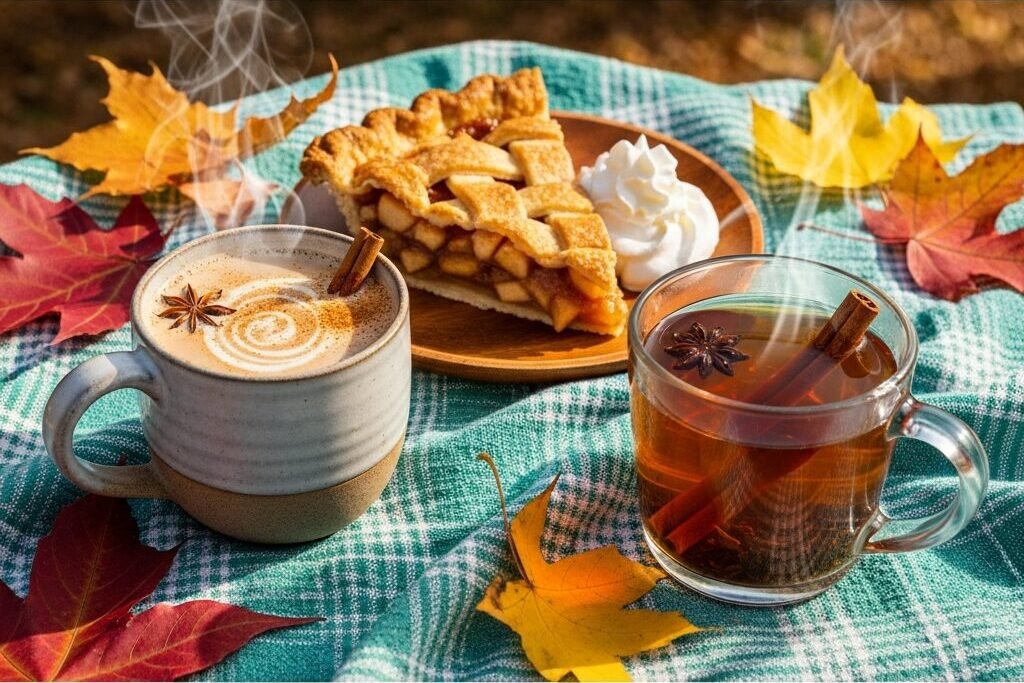
You can steep a strong masala chai or cinnamon black tea to match an apple crisp or apple pie. The sweetness from the fruit highlights the subtle heat in each sip. Cider-based teas also work well alongside caramelized apples and tarts.
Serve spicy black tea with a warm apple turnover for extra comfort on chilly nights. Spices cut through buttery crusts, balancing sugar and tartness from the apples. Tannins from the tea keep every bite refreshing instead of heavy.
What Are the Best Winter Tea and Food Pairings?
Winter tea and food pairings bring warmth and comfort through bold flavors, spiced blends, and fragrant brews perfect for chilly days.
You’ll find your next seasonal favorite among these cozy combinations.
Winter Tea Characteristics
Deep flavors stand out in winter teas. Black tea, aged pu-erh, and spiced blends show notes of malt, earth, and warming spices.
Strong aromas like cinnamon or clove often fill the cup. These teas carry rich color and feel smooth yet full-bodied on the tongue. Steeping these teas produces a liquor that warms you from within.
Many feature higher tannin content for boldness that pairs with hearty food. Leaves are typically harvested earlier but gain complexity during post-processing or aging before winter release. You’ll notice lingering finishes and balanced bitterness after each sip.
Black Tea with Comfort Foods
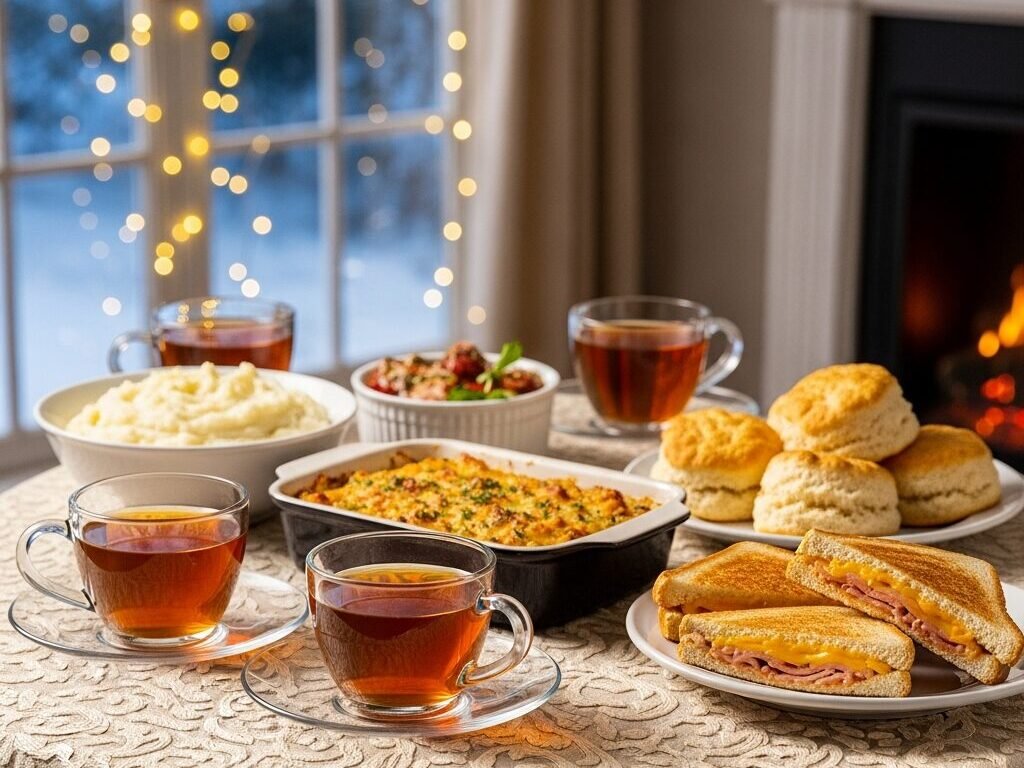
Black tea stands out with its strong, malty flavor and full body, which balance rich winter dishes.
The slight astringency in black tea cuts through the heaviness of creamy mashed potatoes or savory casseroles. Steeped black tea also matches well with grilled cheese sandwiches or fluffy biscuits fresh from the oven. Its bold notes enhance flavors in roasted meats, hearty pasta bakes, and fried chicken.
You can serve English Breakfast alongside meatloaf and gravy. Assam adds brightness to shepherd’s pie on frosty evenings. Choose Earl Grey if you want an aromatic hint of citrus next to buttery scones or a slice of banana bread warming your hands on a cold night.
Chai with Winter Baking

Chai naturally steps in as temperatures drop and baking scents fill the air. Chai blends use bold black teas mixed with warming spices like cardamom, cinnamon, ginger, and cloves.
These ingredients echo classic winter flavors often found in baked goods such as cinnamon rolls, spice cakes, or gingerbread cookies. The milkiness of a creamy chai softens sweet pastries while its heat cuts through heavier textures. Home bakers pour steaming cups of masala chai to enjoy freshly-baked scones or nutty biscotti straight from the oven.
Shortbread cookies dipped into hot chai soak up the blend’s sweet and spicy notes for an extra treat. Even chocolate brownies gain richness beside a strong cup of chai tea steeped with star anise or black peppercorns.
Pu-erh with Rich Winter Meals
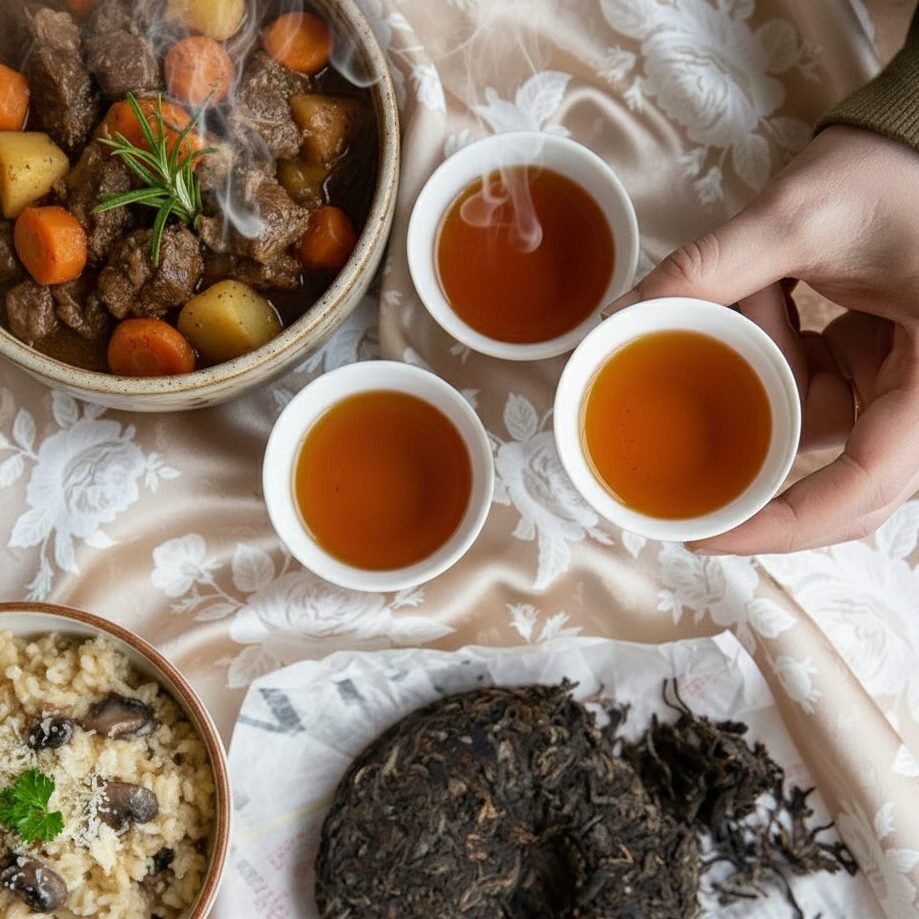
Pu-erh tea delivers earthy and deep flavors that match the richness of winter meals. Its aged profile stands up well to braised meats, lamb stews, or mushroom risotto.
Chefs in Yunnan often serve ripe pu-erh alongside pork belly or hotpot as early as December when temperatures drop below 40°F. Aged pu-erh acts almost like a palate cleanser, cutting through heavy sauces and lingering spices.
You should try combining dark cooked pu-erh with slow-cooked beef stew or duck confit. The tea’s minerality enhances umami-rich dishes full of root vegetables and wild mushrooms. Complex notes in pu-erh mingle with savory winter foods to create a balanced, warming meal experience perfect for cold evenings.
Herbal Tea with Citrus Desserts
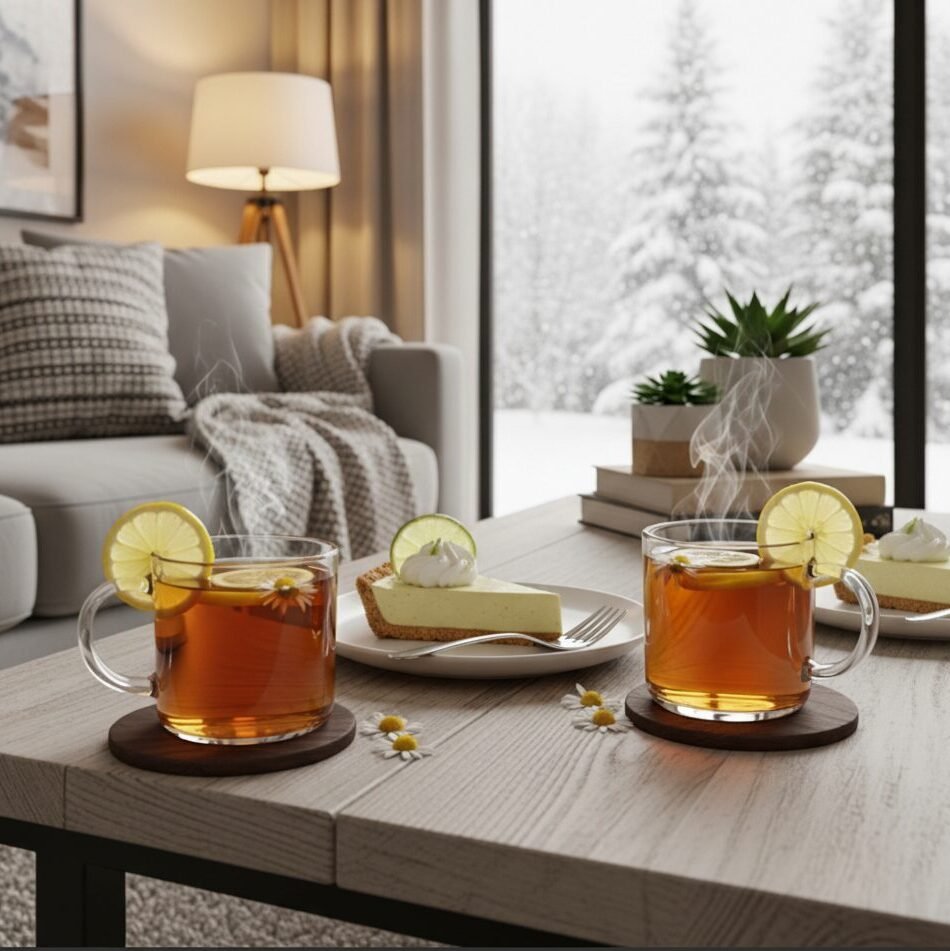
Chamomile, lemongrass, and peppermint teas pair beautifully with citrus desserts in winter.
Citrus tarts or lemon bars brighten the palate while herbal infusions calm the senses. The fresh tang of orange slices lifts floral notes from chamomile tea. Peppermint’s cooling effect contrasts beautifully with sweet-sour key lime pie.
Each sip highlights gentle herbs and zesty fruit without overpowering flavors. Serve hot herbal tea next to chilled grapefruit sorbet for a pleasing temperature contrast during cold months.
How to Create Seasonal Tea Pairing Menus
You can plan seasonal tea pairing menus that highlight local flavors and transform your table.
Smart planning matches tea harvests with every season’s best foods, creating memorable experiences for you and your guests.
Planning by Season

Planning tea pairing menus by season helps create memorable food and drink experiences. Focus on seasonal ingredients to bring out the best in both tea and food.
Spring delivers tender green vegetables like asparagus and peas, which match bright green teas. Summer brings ripe berries, sweet corn, watermelon, and grilled dishes that shine next to cold brew or iced teas. As days cool in fall, roasted root vegetables or baked pumpkin pair well with earthy oolongs or rich black teas. Winter calls for hearty meals. Serve spiced chai with gingerbread cookies or strong pu-erh with braised meats.
Consider local produce calendars as you plan your seasonal tea pairing menus. Seek fresh herbs for spring salads or late-summer fruits for herbal blends. Match the harvest period of certain teas, like first-flush Darjeeling in spring, with foods also at their peak flavor during that time of year.
Sourcing Seasonal Ingredients
Local farmers’ markets offer some of the freshest seasonal fruits, vegetables, and herbs for tea pairing menus.
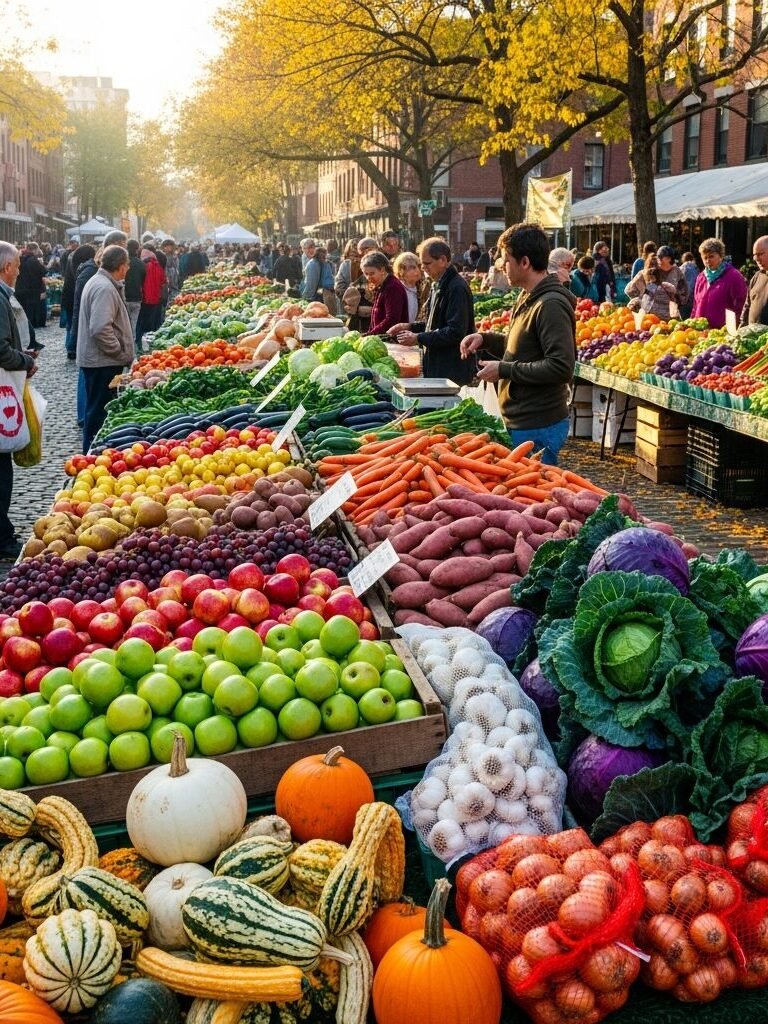
Growers typically harvest produce at peak ripeness. Flavors are brighter and textures crispier compared to out-of-season options from supermarkets. Selecting ingredients such as spring asparagus or fall apples ensures each dish highlights its natural qualities alongside your chosen tea.
Checking local crop calendars can help you discover what is currently in season near you. Many online resources list regional harvest times so you can plan pairings with teas harvested in matching months. Each ingredient brings distinct aromas and tastes that enhance both food and tea experiences throughout the year.
Matching Tea Harvest to Food Season
Tea farmers often harvest teas in sync with the seasons.
Spring brings delicate green and white teas, which pair beautifully with fresh asparagus or peas because their flavors are both subtle and bright. Summer yields robust oolongs and vibrant herbal blends, ideal for grilled vegetables or seafood. These richer teas stand up to heartier outdoor meals.
Autumn sees black tea and aged pu-erh reach peak flavor, matching perfectly with pumpkin dishes or roasted root vegetables that fill fall tables. In winter, strong black teas and spicy chai suit rich meats or baked treats full of warming spices. Aligning a tea’s harvest time to seasonal food creates more harmonious pairings at any table.
What Are Traditional Seasonal Tea Customs?
Many cultures shape seasonal tea customs with unique rituals and pairings.
You can explore how traditions influence both the selection of teas and their seasonal accompaniments.
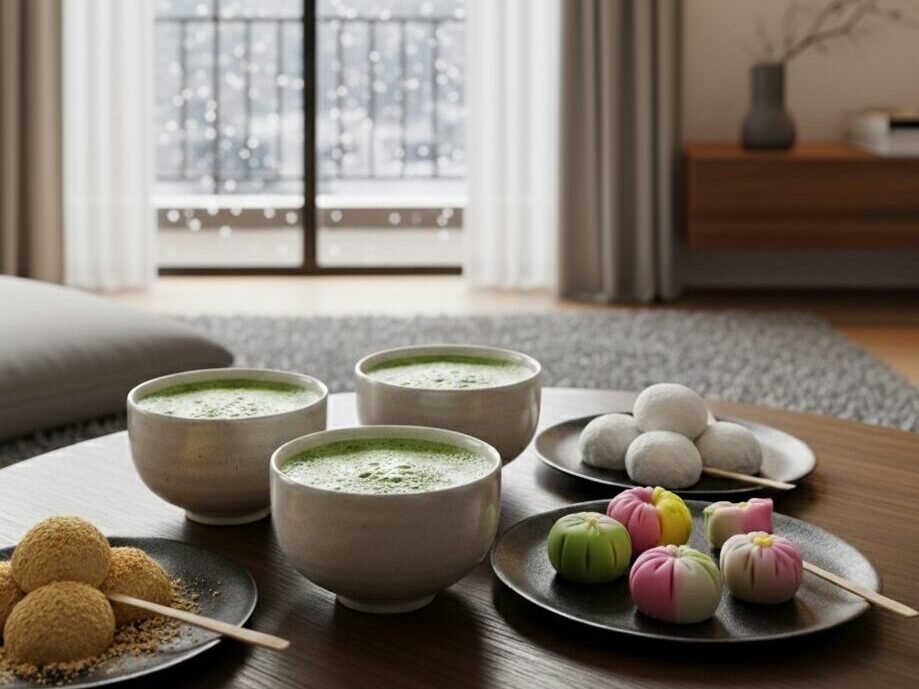
Japanese Seasonal Tea Traditions
Japanese tea traditions highlight the beauty of each season. Tea masters prepare different types of tea and use seasonal ingredients to reflect nature’s changes.
In spring, hosts serve shincha, or “new tea,” which offers a bright, grassy flavor that pairs well with delicate sweets made from cherry blossoms or young leaves. Summer gatherings often feature cold-brewed sencha poured over ice and garnished with fresh citrus peel for a cooling effect.
Autumn celebrations focus on roasted teas such as hojicha that match the earthy flavors found in chestnut desserts or grilled sweet potatoes. Winter brings thick, frothy bowls of matcha paired with red bean confections and chewy rice cakes called mochi. Within every Japanese seasonal tea practice, tableware also shifts. Pale pink sakura cups appear in spring while deep-hued ceramics mark winter occasions.
Chinese Seasonal Tea Practices
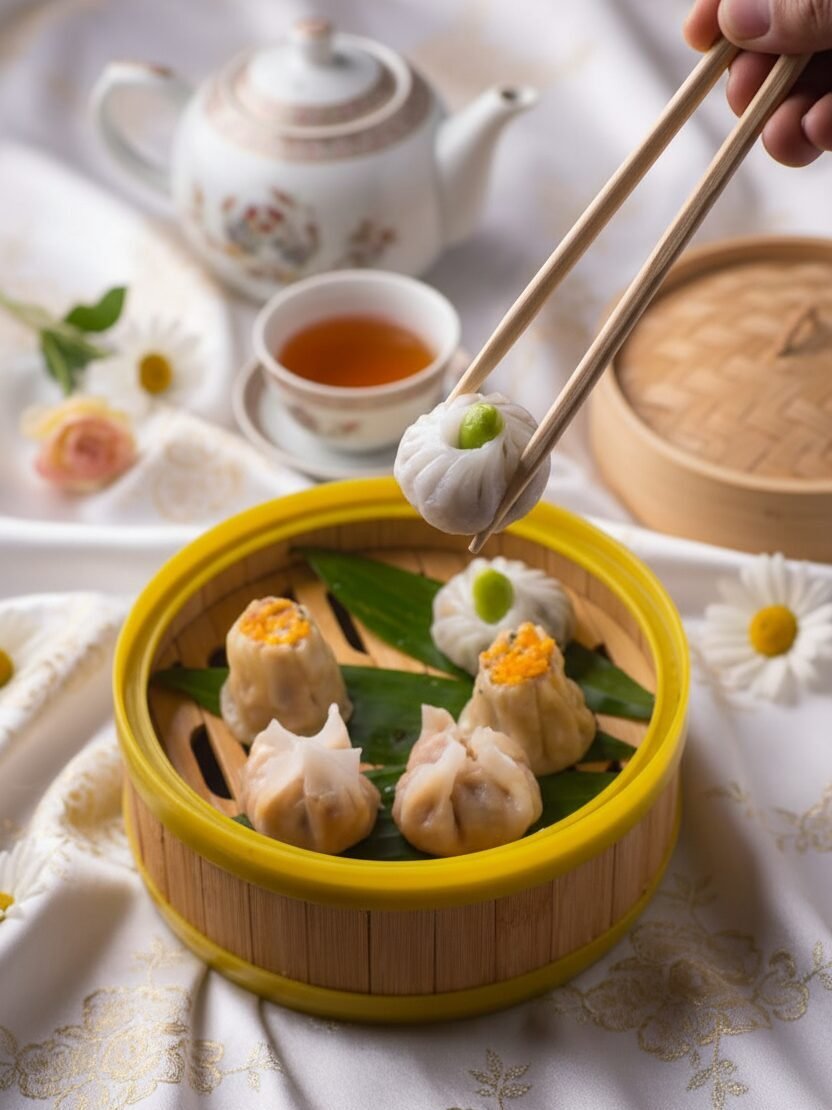
China roots its tea practices in ancient agricultural cycles and local climate patterns. Tea farmers select specific harvest times based on nature’s signals.
The Qingming Festival in early April marks the first plucking of prized green teas like Longjing. Across southern provinces, people drink lighter teas like fresh green or high mountain oolong to match spring’s gentle warmth. Colder months inspire communities in northern China to enjoy dark teas such as pu-erh with hearty foods, which help warm the body.
In Cantonese culture, families often serve floral white or jasmine-scented teas alongside delicate dim sum dishes during spring and summer gatherings. As each season changes, Chinese households adjust brewing styles, steeping time, and water temperature, to pair with both food flavors and weather conditions throughout the year.
Western Seasonal Tea Rituals
British afternoon tea stands out as a classic example that adapts its offerings with each season. In spring, light teas such as Darjeeling often join cucumber sandwiches or lemon cakes during midday gatherings.
Summer brings iced black tea alongside fresh berries or scones filled with clotted cream. Autumn tables feature robust Assam or spiced chai paired with apple tarts and pumpkin bread. Winter afternoons often include rich English Breakfast blends served hot, accompanied by mince pies and buttery shortbread for warmth.
Across Europe and North America, these moments highlight how people select both the type of tea and its food partner based on climate changes throughout the year.
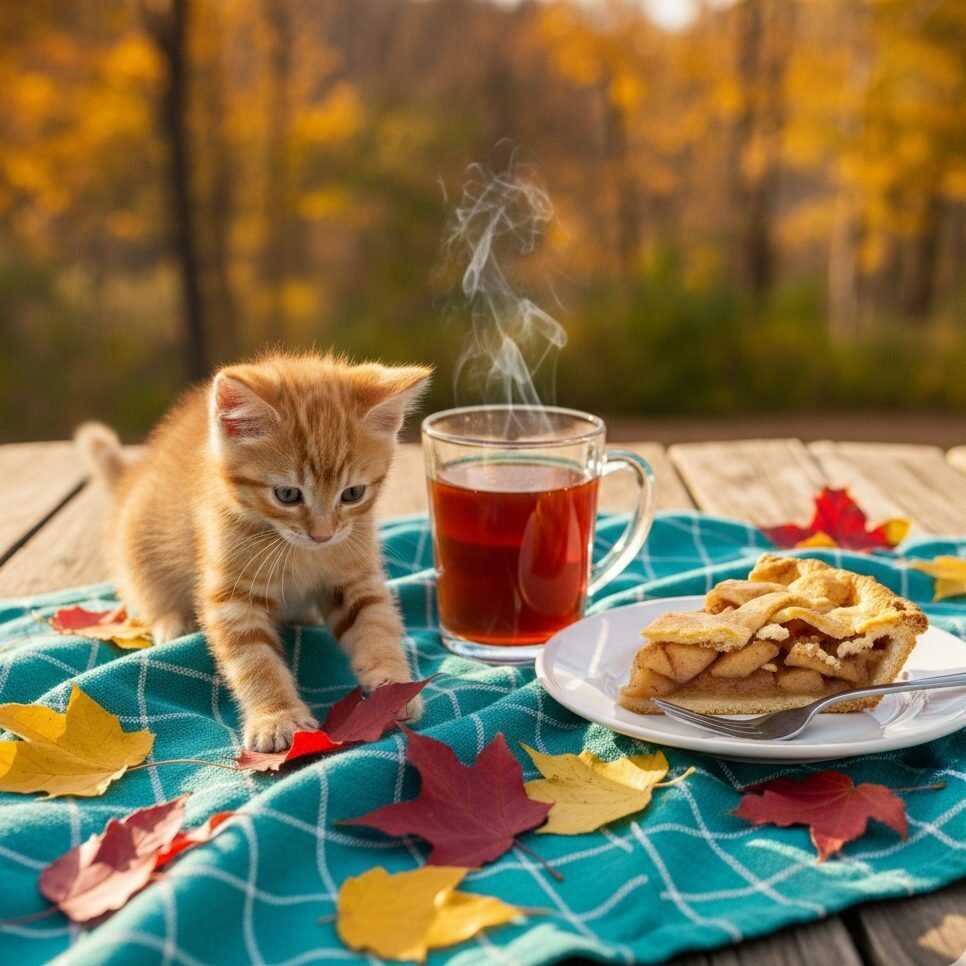
Conclusion: Embracing the Rhythm of Seasonal Tea Pairing
Seasonal tea pairing invites us to taste the harmony between nature’s cycles and our daily meals.
Each season brings fresh flavors, new aromas, and unique combinations that can make both tea and food shine brighter together. Exploring these pairings turns each cup into a celebration of the present moment.
Savor what every season offers, and discover how well-chosen teas can transform your table all year long.
FAQs
1. What is the main benefit of seasonal tea pairing?
Seasonal tea pairing enhances your dining experience by matching teas with ingredients when they are at their peak freshness. This creates a natural harmony of flavors that are designed to go together, making both the food and the tea taste better.
2. What are some classic spring tea and food pairings?
Spring pairs light, fresh teas with tender new produce. The article recommends:
- First Flush Darjeeling with spring vegetables like asparagus and peas.
- Green Tea (like Sencha) with asparagus, as its grassy notes match well.
- White Tea with light spring salads, strawberries, and rhubarb.
3. What teas work best for summer meals and grilling?
Summer calls for refreshing teas that can balance smoky or spicy flavors. The article suggests:
- Iced Black or Green Tea to cut the richness of barbecue and summer meals.
- Oolong Tea with summer seafood like grilled shrimp or crab.
- Herbal Teas (like Hibiscus) with tropical fruits like mango and pineapple.
4. How should I pair tea with fall flavors like pumpkin and squash?
For the buttery, sweet flavors of pumpkin and squash, the article recommends a bold Black Tea, as its briskness balances the creamy texture. For other fall foods, it suggests Oolong with roasted root vegetables (like carrots) and Spiced Tea with apple desserts.
5. What is the best tea for rich, hearty winter stews and meals?
The article specifically pairs Pu-erh tea with rich winter meals and hearty stews (like beef stew). Its deep, earthy flavor stands up to braised meats and rich broths. For other winter foods, it pairs Chai with winter baking (like gingerbread) and Black Tea with general comfort foods.
6. Does the temperature of the tea matter for pairing?
Yes, very much. The article highlights that serving hot tea in winter amplifies the warmth and comfort of hearty dishes. In contrast, cold brew and iced teas are perfect for summer, offering a crisp, refreshing balance to smoky grilled foods and cooling your palate on hot days.

